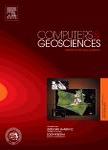版权所有:内蒙古大学图书馆 技术提供:维普资讯• 智图
内蒙古自治区呼和浩特市赛罕区大学西街235号 邮编: 010021

作者机构:Cent S Univ Computat Geosci Res Ctr Changsha 410083 Hunan Peoples R China Univ Western Australia Sch Earth & Environm Crawley WA 6009 Australia
出 版 物:《COMPUTERS & GEOSCIENCES》 (计算机与地学)
年 卷 期:2019年第123卷
页 面:103-110页
核心收录:
学科分类:08[工学] 0708[理学-地球物理学] 0812[工学-计算机科学与技术(可授工学、理学学位)]
基 金:Natural Science Foundation of China
主 题:Convective seepage flow Computational modeling Finite element method Steady-state solver Porous rock
摘 要:Convective seepage flow plays a key role not only in naturally forming mineral deposits and oil reservoirs, but also in the carbon-dioxide sequestration in fluid-saturated rocks. This paper presents a steady-state numerical solver, which is based on the finite element method (FEM) and progressive asymptotic approach procedure (PAAP), to solve steady-state convective seepage flow problems in fluid-saturated heterogeneous rocks. Although this kind of flow problem is commonly solved by using transient-state numerical solvers, the use of the proposed steady-state numerical solver, which is the main characteristic of this study, can have certain advantages. After the proposed steady-state numerical solver is verified by a benchmark testing problem, for which analytical solutions are available for comparison, it is further applied to simulate steady-state convective seepage flow in the Australia North West Shelf basin, which is composed of naturally-formed heterogeneous porous rocks. Through the simulated numerical results, it can be found that: (1) compared with the analytical solutions of the benchmark testing problem, the use of the steady-state numerical solver can produce correct and accurate numerical simulation results for dealing with convective seepage flow problems in fluid-saturated heterogeneous rocks. (2) The main advantage of using the steady-state numerical solver is to avoid the need of considering initial conditions of the problem, which are commonly difficult to be determined because the convective seepage flow within the upper crust is a past event in geology. (3) In the Australia North West Shelf basin, the convective seepage flow and temperature distribution patterns depend strongly on both the permeability contrast of the faults and the basin geometry (including the layer structures and fault locations) in the computational model.